Abstract
Doppler tomography (DT) is a relatively new method that allows the imaging of cross-sections of an object. The method uses a two-transducer ultrasound probe that moves around or along the object in a specific way. Image reconstruction is performed on the basis of the detection of the so-called Doppler signal, which contains Doppler frequencies that identify the stationary heterogeneous structures inside the imaged cross-section of the object. The Doppler tomography method differs significantly from the popular blood flow velocity detection method and should not be confused with it. It can potentially be used to reconstruct 2D and 3D cross-sectional images of structures that reflect the ultrasound wave well, either in medicine for diagnostics or in industry for so-called non-destructive testing. This paper presents simulations of imaging using Doppler tomography. The method and algorithms that can be used for Doppler tomography imaging without the need for complicated measurement systems and calculations were proposed. The influence of selected parameters on DT imaging quality was investigated, and their optimal compromise values for specific conditions were determined. Ways to improve image quality were also discussed.
1. Introduction
The Doppler phenomenon is currently used in many ways in a wide variety of measurement and diagnostic methods. One such comparatively little-known method is continuous wave ultrasound tomography (CWUT), otherwise known as Doppler tomography (DT). It allows the reconstruction of an image of a stationary object structure that scatters ultrasound waves effectively. The DT method uses a two-transducer sending–receiving ultrasound probe. Similar probes are also used in the classic method of measuring blood flow velocity in blood vessels, but in DT, to induce the Doppler effect, the probe moves close to or around the tested object, while it is stationary. This allows signals to be reflected from heterogeneous structures within the cross-section of the object being imaged. Each such signal has its frequency altered from the transmitted one by a so-called Doppler frequency. Based on Doppler frequencies, tomography image reconstruction is performed in this method. The DT method differs significantly from classical Doppler imaging of blood flow (continuous wave Doppler (CWD), pulsed wave Doppler (PWD)) or physiological tissue movement imaging (tissue Doppler imaging (TDI)), as the scatterer movement (discontinuities) in the tissue is induced artificially and has nothing to do with blood flow. It also differs significantly from standard ultrasound echographic methods. In ultrasound B-mode imaging, which is widely used in medical diagnostics, the main parameters allowing image reconstruction are the time and amplitude of the echoes scattered backwards over the heterogeneities in the structure of the tissue cross-section being examined. The same is true for ultrasound nondestructive testing, which enables the detection of various types of flaws (cracks, delaminations, inclusions) within solid bodies, which are structural components of machines or buildings. The DT method is still under development, and specific applications have not yet been identified [1,2]. Potentially, it can be used to reconstruct 2D and 3D cross-sectional images of structures that reflect the ultrasound wave well, for medical or material diagnostics. One potential medical application is the imaging of bone structures, which reflect ultrasound waves, for monitoring fracture adhesions and bone injuries in the extremities or for detecting neoplastic lesions in the breasts [3].
This paper presents imaging simulations using Doppler tomography. It proposes a method and algorithms that can be used for Doppler tomography imaging without the need for complex measurement systems and time-consuming calculations. In addition, the influence of selected parameters on the quality of DT imaging was investigated, and their optimal compromise values for specific conditions were determined. Ways to improve the quality of the DT image were also discussed. This research is novel and has so far not been carried out as thoroughly by the few research teams working on the development of Doppler tomography methods.
2. Measuring Geometries
In the case of Doppler tomography, two geometries are mainly used to move the ultrasound probe and acquire measurement data simultaneously [4]. In the first case shown in Figure 1a, the probe moves along the imaged object. This method of data acquisition is called linear geometry. In this geometry, a dual-transducer ultrasound Doppler probe is moved at a constant speed in a straight line along a stationary imaged object. The probe generates a continuous quasi-flat ultrasonic wave that covers the entire imaging zone. At specific moments in time, the receiving transducer in the probe receives signals reflected from inclusions and structures inside the object being examined. The ultrasonic signal has the chance to reflect off structures whose acoustic impedance differs from that of the surrounding environment. At a given moment, for a fixed movement (displacement) of the probe, all scatterers located in the structure of the object on each line at a fixed directional angle φ have the same effective speed of movement in that direction, which implies the same Doppler frequency value. For each position of the probe, the amplitude of the received signal spectrum for each fixed Doppler frequency can therefore be treated as a linear integral of all waves reflected from the scatterers located along the line at a given directional angle φ. The determination of the spectrum of signals recorded for individual probe displacements and the amplitude values of each received signal for individual Doppler frequencies is similar here to that in the case of circular geometry, which was described in detail in Section 3 [5,6].
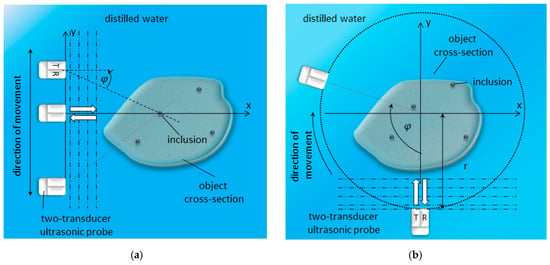
Figure 1.
Geometries of ultrasound probe movement and data acquisition in Doppler tomography: (a) linear geometry; (b) circular geometry.
In the second way of data acquisition, shown in Figure 1b, the probe moves around the imaged object. This is called circular geometry. This paper focuses mainly on the circular geometry method, which allows for more accurate results to be obtained [5,6].
3. Measurement Data Acquisition and Processing
In the DT method, the Doppler frequency remains the same regardless of whether the ultrasound probe rotates around the tested object or whether the tested object rotates around its own axis and the probe remains stationary. In order to introduce the idea of DT imaging, it is easier to use the case of object rotation, and this is the approach adopted in this paper and in the simulations carried out. Of course, in the case of real measurements and imaging of the object structure in real time, it is necessary to develop a method to rotate the probe around a stationary examined object. As mentioned earlier, unlike the Doppler imaging used in ultrasound B-Mode scanners, DT imaging is based on the measurement of the frequency of Doppler signals reflected from stationary structures within the tested object that scatter ultrasound. The idea of DT imaging can be explained by the example illustrated in Figure 2a. In this figure, you can see a cross-section of the imaged object, which contains three inclusions with very small diameters—a, b, and c (pins). Let us assume that the surroundings of the inclusions are homogeneous and only these inclusions scatter and reflect the ultrasonic wave. In this example, as previously established, the ultrasonic probe remains stationary during measurement data acquisition, and the object rotates around the center of the coordinate system together with the inclusions. This means that each inclusion rotating at the same angular velocity has a different linear velocity component (, , ) in the Y-axis direction (Figure 2a), increasing with distance from the axis of rotation. Measurement data acquisition in the DT method consists of recording the so-called Doppler signal at successive angles of object (or probe) rotation. The Doppler signal is determined from the continuous ultrasonic signals recorded at individual angles of rotation and reflected from all the ultrasonic reflectors rotating in the object, i.e., structures capable of backscattering the ultrasonic signal toward the receiving transducer of the ultrasonic probe. The Doppler signal (i.e., the signal containing the differential frequencies between those contained in the received signal and those contained in the transmitted signal) is acquired by processing the receiving signal in a similar way to standard continuous wave Doppler (CWD) imaging used in blood flow measurements. The most common approach here is to convert the transmit and receive signals into an I/Q form, where I stands for the in-phase signal and Q is the so-called quadrature signal. I/Q signals are derived from demodulation of the radio frequency (RF) signal received by the ultrasound probe, splitting it into two orthogonal components [7,8]. The I(t) signal represents the component of the received signal that is in phase with the transmitted signal, while the Q(t) signal represents the component that is 90° out of phase. This process allows for the accurate measurement of Doppler shifts, which are directly proportional to the velocity of the blood flow (and, in the case of DT, the motion of the reflectors). This method is illustrated in Figure 3. The sending transducer of the ultrasound probe generates a continuous sinusoidal signal at a fixed pulsation , where the frequency is typically around 4–8 MHz:
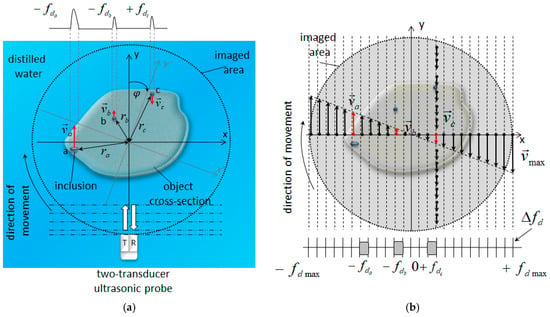
Figure 2.
Idea of DT imaging: (a) imaged cross-section of the test object with three inclusions (a, b, and c) reflecting the ultrasonic wave; (b) distribution of motion velocity components along the direction of wave propagation and Doppler frequency in the imaging area.
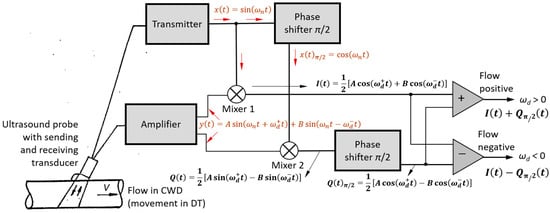
Figure 3.
Method of determining the Doppler signal in the CWD (and DT) method by means of processing the receiving signals into I/Q form.
The receiving transducer of the ultrasound probe receives signals with increased frequencies due to the Doppler phenomenon () and decreased frequencies (), which takes the following form at the amplifier output:
where represents Doppler frequency increasing the frequency of the transmitting signal (movement of inhomogeneities toward the probe), represents Doppler frequency decreasing the frequency of the transmitting signal (movement of inhomogeneities away from the probe), and A and B represent signal amplitudes. As a result of multiplying the transmit and receive signals in Mixer 1, the signal at its output takes the following form:
Once the high-frequency components of such a signal (() and ()) have been filtered out using a low-pass filter (LPF), it takes the form of an in-phase signal:
Shifted in phase by π/2, the transmit signal x(t) takes the form of a cosine and, when multiplied by the received signal y(t), at the output of Mixer 2 is expressed by the following formula:
After filtering out the high-frequency components (() and ()) with the LPF and after a π/2 phase shift, it takes the form of a quadrature signal:
After such processing, the signals represented by Formulas (4) and (6) already contain only Doppler frequencies, which can be determined using the FFT transform. Furthermore, by means of the sum and difference of these signals, it is possible to separate the Doppler signal for the inhomogeneity motion toward the probe and for inhomogeneity motion away from the probe . In the DT method, it is assumed that if, for a given rotation angle, the inclusion moves toward the probe, the Doppler frequency has a positive sign, and if the movement is in the opposite direction, it has a negative sign.
The components of the linear velocity of motion of the inclusions along the direction of wave propagation (, , ) are related to the Doppler frequency by the following formula:
where ωturn represents the angular velocity of rotation of the test object (or rotation of the probe around the object), r represents the distance of inclusion from the center of rotation, c represents the propagation velocity of the ultrasonic wave along the propagation path in the medium, φ represents the angle of rotation of the test object (probe), fT represents the frequency of the signal sending from the ultrasonic probe. Based on Equation (7), the formula for velocity v along the direction of wave propagation can be derived:
From Equation (8), it can be deduced that the velocity component along the direction of wave propagation v is directly proportional to the Doppler frequency. It should also be noted that the inclusions on each line along the propagation of the ultrasonic wave have the same velocity value v, as illustrated in Figure 2b. The dashed vertical lines here represent the direction of propagation of the ultrasonic wave (assuming that it is a plane wave). Using inclusion c as an example, it can be observed that, for a given angle of rotation, on the dashed line passing through this inclusion, the velocity values v are always the same, irrespective of the value of its position coordinate y. From Equation (8), it can also be deduced that the same relationship is valid for Doppler frequencies originating from an inclusion located on any vertical line. In turn, as we move farther away from the center of rotation (the center of the imaging zone) parallel to the Y-axis, the velocity v increases to a maximum value of at the boundary of the imaging (rotation) zone.
4. Image Reconstruction
In image reconstruction, Doppler tomography and the method of measuring blood velocity using the Doppler effect have much in common. In both cases, the basis for calculating the result is the Doppler signal, which is recorded using a two-transducer ultrasound probe. Additionally, in both methods, the most common approach is to convert the transmit and receive signals into an I/Q form. When signals are derived by demodulating the radio frequency (RF) signal received by the ultrasound probe, they are split into two orthogonal components. Similarly, signals A and B are obtained, and the STFT process is used. All these similarities mean that in the future, after constructing a device based on the DT method, it will be possible to use the imaging methods presented in [9,10]. However, it is important to remember not to confuse blood velocity measurement using the Doppler effect with Doppler tomography.
Recorded Doppler receiving signals that are fed into reconstruction algorithms can be considered as complex, characterized by amplitude and phase (the so-called analytical) or as real, in which only amplitude is considered. Therefore, there are two corresponding image reconstruction methods, namely incoherent and coherent [5,11]. The incoherent image reconstruction in the DT method is implemented using classical reconstruction algorithms used in conventional X-ray computerized tomography (CT) [5], with the filtered back projection (FBP) algorithm or reconstruction by Fourier inversion being the most commonly used [12]. Due to the extensive experience in implementing transform-based tomography image reconstruction algorithms [13,14] by the authors, applied in the prototype ultrasound tomography scanner developed for the examination of women’s breasts, and due to the ease and speed of the calculations, the FBP algorithm with the Ram–Lak filter was used for image reconstruction in the DT method [4,15].
In the FBP algorithm, the projection values subjected to the reconstruction of the DT image are the real values of the accumulated amplitudes of the Doppler spectrum determined in the Δfd sub-bands of the range of recorded Doppler frequencies [−fdmax; +fdmax] for individual angles of rotation (with angular step Δφ). This range is determined by the maximum and minimum distances of the extreme scatterers (e.g., boundaries of the object cross-section under examination) rmax (Formula (7)) from the center of rotation of the ultrasound probe and corresponds to the imaging zone (Figure 2b). This range should then be divided into the so-called Doppler bands of equal width Δfd. This corresponds to the division of the imaging zone into individual bands marked with dashed lines in Figure 2b. The width of the Doppler band is assumed to be derived from the resolution of the Doppler signal and is equal to the minimum bandwidth of this spectrum. In the next step, for each rotation angle φ, the sums of the fd frequency amplitudes (that is, the amplitudes of the individual bands of the spectrum) are to be written to the corresponding Doppler bands. This creates an array called a sinogram in tomography reconstruction [4]. In DT, each row of this array corresponds to a given angle of rotation (the so-called projection), while its individual cells correspond to successive Doppler bands (the so-called rays). Once the sinogram has been determined, the final step in DT image reconstruction is to apply the chosen image reconstruction algorithm, such as that used in CT [13,16]. As mentioned above, the efficient FBP algorithm [15] was used in this study. This is a fast algorithm that allows the image to be determined from only half of the full rotation data of the test object (or probe), that is, using a Doppler signal in the form of or in the form of (Figure 3). With correctly conducted measurements, the two images should not differ. The inconsistent DT image reconstruction procedure is shown schematically in Figure 4.
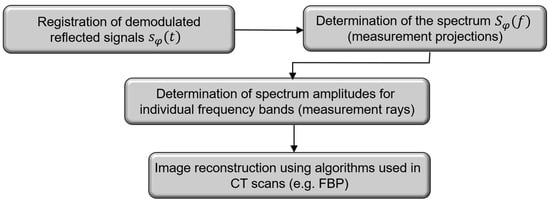
Figure 4.
Scheme of incoherent image reconstruction in the DT method.
5. Doppler Signal Simulation
Image reconstruction in the DT method requires the recording of a receiving signal and processing it into a Doppler signal (Figure 3). For the simulation, the calculation of the target Doppler signal is sufficient. Based on the previously described example of a small single inclusion (pin) rotating on a rotating platform, it can be concluded that the frequency of the signal received by a stationary ultrasonic Doppler probe is as follows:
where fR is the frequency of the received signal. The ‘+’ or ‘−’ sign at the Doppler frequency determines the direction of motion of the inclusion:
According to Formula (10), the inclusion can move toward the probe (then because ) or away from it (then because ).
For a single small-diameter pin-type scatterer placed on a rotating platform immersed in water, at a distance r0 from its center of rotation, at an angle φ0 to the origin of the coordinate system, and with the platform rotating at a frequency fturn, the Doppler signal can be determined using the following formula [15]:
where A is an arbitrary value of the signal amplitude. It should also be noted that the platform, together with the scatterer, is in this case immersed in distilled water with an ultrasonic wave velocity cw.
When simulating a signal from multiple pin-type inclusions, the Doppler signals can be determined for each separately using Formula (11) and then summed.
6. Overlapping Algorithm
Measurement data acquisition requires the registration of the reflected signal for each rotation of the test object (or rotation of the probe around the object). In practice, signal registration is most easily done continuously over time. Thus, it is necessary to record the signal for one or more complete rotations and then divide it into equal parts corresponding to each rotation angle. A similar method of measurement data acquisition is used when determining the instantaneous spectrum of a sound signal in the process of making studio recordings in sound production or to calculate the time-varying spectrum of blood flow velocity in blood vessels (the so-called Doppler blood flow waveform) in ultrasound medical diagnostics. This uses a method based on a short-time Fourier transform (STFT) analysis with filtering using window filters [17,18]. The STFT method involves moving a time window of a given length (the number of samples usually being a power of 2) with a certain step along the Doppler signal and analysing the frequency composition of such a signal in each window. In conventional digital signal processing applications, the STFT is often determined only in a finite set of equally spaced points along the frequency axis (similar to the discrete Fourier transform (DFT) instead of the discrete-time Fourier transform (DTFT)) [19,20]. From a qualitative point of view, the STFT can be defined as a set of fast Fourier transforms (FFTs) performed on overlapping time segments in which the signal has been previously divided by a translating window (e.g., Hamming, Hanning window) in time. To apply the FFT, the length of the time window is chosen short enough to guarantee the pseudo-stationarity hypothesis for each signal segment. In this way, the STFT is computationally efficient and allows the spectrum of the Doppler signal to be analyzed in real time. Note that the length of the time window affects both the temporal resolution and the frequency resolution of the STFT. A narrow window results in high temporal resolution but coarse frequency resolution because it has a short duration but a wide frequency bandwidth. A wide window results in high-frequency resolution but coarse temporal resolution because it has a long duration but a narrow frequency bandwidth. This phenomenon is called the window effect. With STFT, it is not possible to achieve high temporal and frequency resolution at the same time; some compromise has to be established. The time window can be shifted along the signal to be analyzed with or without overlap. Overlapping the sliding window makes the STFT smoother along the time axis. Overlapping should be used in particular if the signal length is small. The idea of the overlapping algorithm designed by the authors to divide the Doppler signal into angular windows in the process of determining the sinogram for the reconstruction of the DT image is shown in Figure 5.
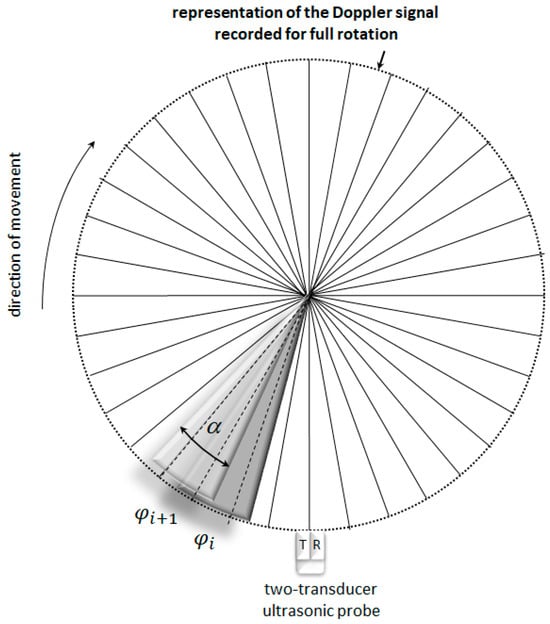
Figure 5.
Illustration of the division of the Doppler signal recorded from a full rotation into individual data acquisition angles φi and φi+1 (measurement projections).
The circle in Figure 5 represents the recorded Doppler signal from a complete rotation of the test object (or probe). This circle has been divided into equal slices. Each slice represents one rotation angle φ (measurement projection). As already mentioned, for image reconstruction using the DT method, it is necessary to determine the Doppler signal spectra for each angle. However, for such a simple division of the signal (without angular overlapping), the resolution of the Doppler spectrum Δfd is too small:
where fs is the sampling frequency and N is the number of samples of the signal. Increasing the sampling frequency will not increase the resolution of the spectrum, because the number of samples N increases at the same time and the resolution remains the same. Increasing the resolution of the Doppler spectrum in the DT method is crucial because the smaller the value, the more Doppler bands can be distinguished in the spectrum. In turn, the higher the number of Doppler bands, the better the resolution of the DT image [19].
The main idea of the overlapping algorithm is to increase the number of samples for the angles φ while maintaining the value of the sampling frequency. This allows for an increase in the resolution of . As a result of this angular window overlapping operation, the Doppler signals for two adjacent angles φi and φi+1 (Figure 5) will have common parts.
The parameter α (Figure 5) is responsible for the length of the Doppler signal for the angles of rotation φ (time window). For simplicity, it was assumed that it would be expressed in angular measure, i.e., it would be the width of the angle relative to a complete rotation (360°). It should also be specified here that the middle value in the width range α was taken as the representation of the rotation angle φ, as shown in the example of angle in Figure 6. Additionally, it should be noted that a standard rectangular window was used to determine the time window with a length of α.
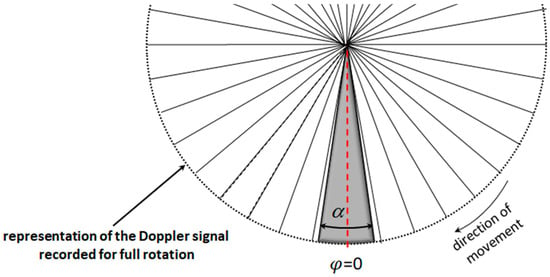
Figure 6.
Illustration of the determination of the Doppler signal of width α for a rotation angle .
7. Studies on the Influence of Selected Parameters on the Quality of the Image
In this section, the influence of the number of rotation angles φ and the value of the overlapping parameter α on the imaging quality of the DT method is investigated. Furthermore, the optimal values of these parameters were determined for two diameters of the imaging zone: 5 cm and 10 cm. All imaging results presented here refer to simulations of inclusions with very small diameters placed in water. The diameters of the inclusions were assumed to be infinitesimally small (point-like, that is, representing a function of δ(x,y)—Dirac’s delta) but scattering the ultrasound wave uniformly in all directions around without diffraction. The simulations also neglected the attenuation of the ultrasonic wave in the water and assumed that the reflection coefficient at the water/inclusion interface is 100%. This approach makes it possible to verify the minimum inclusion diameter possible to achieve in the DT image as a result of limitations related solely to the method of acquisition of the measurement signals and the method of image reconstruction, assuming the recording of an undistorted continuous Doppler signal corresponding to each inclusion and varying in time as a result of the uniform rotation of these inclusions under ideal conditions.
In the simulations, the platform rotation frequency was assumed to be fturn = 2 rps (rotations per second), the frequency of the transmitted ultrasonic wave fT = 4.0 MHz, the temperature of the distilled water tw = 20 °C, and the number of Doppler signal samples per platform rotation N = 10,000. Doppler signals were determined from Equation (11). The platform was assumed to rotate, and the ultrasonic probe was stationary.
7.1. Influence of the Number of Rotation Angles
The number of rotation angles (Doppler signal registration) was denoted as Nφ. To determine what kind of imaging error is introduced by an inadequate number Nφ, images of 20 scatterers were reconstructed at four different angles: 0°, 90°, 180°, and 270° relative to the position of the ultrasound probe. The distribution of the inclusions is schematically shown in Figure 7a. At each angle, there are five inclusions 1 cm apart, with the inclusion closest to the center of the imaging zone being 0.5 cm from the axis of rotation. The diameter of the imaging zone in this case is 10 cm.
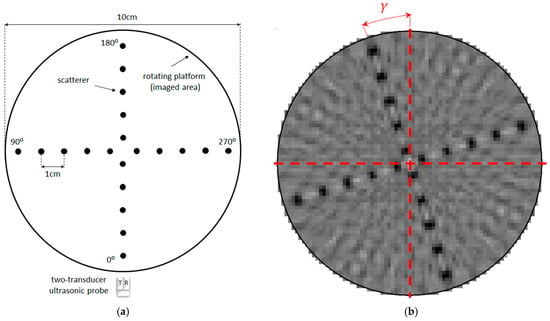
Figure 7.
Arrangement of 20 scatterers on a rotating platform with a diameter of 10 cm (a); image reconstruction of 20 scatterers with the number of rotation angles (Doppler signal registration) equal to 38 (b).
Figure 7b shows the reconstruction of the DT image with a very small number Nφ = 38. An overlapping algorithm with parameter α = 8.1° was used to reconstruct the image. It can be seen that the inclusions have been imaged in an offset, at positions inconsistent with their given position (cf. Figure 7a,b). In Figure 7b, the red dashed line indicates the directions in which the reconstructed images of the scatterers should be located. It can be seen that the further the inclusion is from the center of the imaging zone, the greater the error in reconstructing its position in the DT image. These images are rotated by the angle γ indicated in Figure 7b. As can be seen, the largest imaging error due to the Nφ parameter occurs for objects located on the border of the imaging zone. Therefore, to determine the minimum imaging error depending on Nφ, an inclusion located 5 cm and 2.5 cm from the rotation axis and at an angle of 0° to the ultrasound probe was tested. Since the two test scatterers would be located at the border of the imaging zones, their DT images could be partially distorted (truncated). To avoid this possible image distortion of the inclusions at the border of the imaging zones, the authors adopted the principle that both inclusions (2.5 cm and 5 cm) would be reconstructed in a slightly larger imaging zone with a diameter of 15 cm. An example of such a reconstruction for an inclusion located 2.5 cm from the center of the imaging zone for Nφ = 38 is shown in Figure 8.
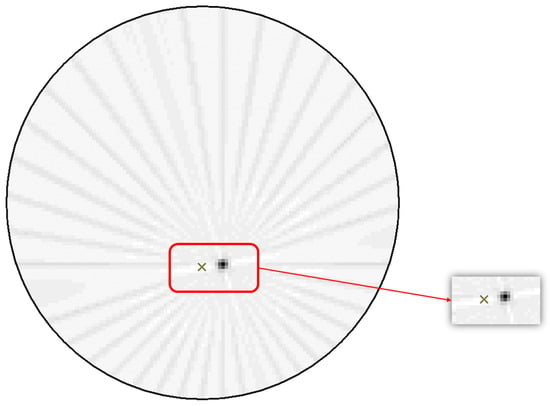
Figure 8.
Reconstructed image of an inclusion placed on a rotating platform 2.5 cm from the center of rotation and at an angle of 0° to the ultrasound probe, with Nφ = 38.
In Figure 8, the symbol “x” marks the position where the center of the inclusion image should be reconstructed. As can be seen, for such a small value of the Nφ parameter, a significant shift error appeared in the inclusion image. A comparative analysis for different values of Nφ was performed on sections of the 18 mm × 34 mm ROI (region of interest) image near the scatterer image (Figure 8 and Figure 9). Successive DT images of inclusion positioned 2.5 cm from the center of rotation were reconstructed for Nφ = 78, 118, 158, 198, 238, 278, 318, 358, 398, 598, 798, 998, 1198, and 1398. The results of these reconstructions for the ROI area specified above are compared in Figure 9, marking the correct position of the inclusion in each image with an “x”.
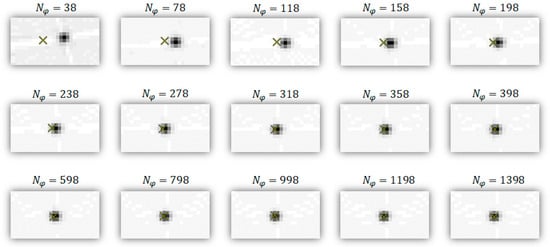
Figure 9.
Reconstruction of the image of an inclusion set 2.5 cm from the centre of rotation for the number of angles Nφ equal to 38, 78, 118, 158, 198, 238, 278, 318, 358, 398, 598, 798, 998, 1198, and 1398, respectively.
From the results, it can be seen that the greater the number of angles Nφ, the closer the reconstructed image of the inclusion approaches the correct location of the inclusion.
Similar tests were carried out for an inclusion placed at a distance of 5 cm from the rotation axis (Figure 10).
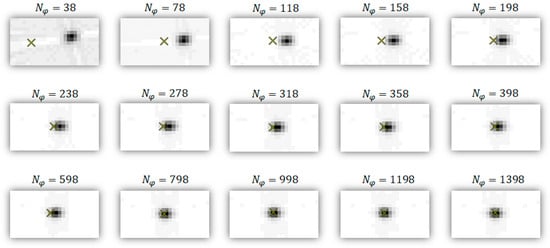
Figure 10.
Reconstruction of the image of the inclusion set 5 cm from the centre of rotation for the number of angles Nφ equal to 38, 78, 118, 158, 198, 238, 278, 318, 358, 398, 598, 798, 998, 1198, and 1398, respectively.
Comparing the results in Figure 9 and Figure 10, it is clear that for small values of Nφ, a larger imaging error occurs for an inclusion located further from the center of the rotation axis (imaging zone). To quantitatively analyze this error, the position error of the inclusion image position error δ was determined for each reconstructed inclusion image (Figure 9 and Figure 10). It was calculated as the distance of the center of the inclusion image from the given coordinates of the location of this inclusion. The results are presented as graphs in Figure 11.
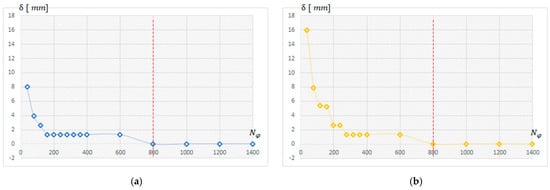
Figure 11.
Graphs of the imaging error of the position of an inclusion located (a) 2.5 cm and (b) 5 cm from the center of rotation, for a number of rotation angles Nφ ranging from 38 to 1398.
In Figure 11, it can be seen that the imaging error δ for small values of Nφ is about twice as large for an inclusion 5 cm away from the center of the image as for an inclusion 2.5 cm away. However, with increasing Nφ, both errors decrease rapidly to values below 2 mm. In addition, for , the error δ ≈ 0. This value is indicated by the red dashed line in Figure 11. Thus, it can be concluded that the optimal limiting value of Nφ for the 5 cm and 10 cm diameter imaging zones is Nφ ≈ 798. Figure 12 additionally shows the reconstruction results of 20 scatterers (Figure 7a) for Nφ = 38 and Nφ = 798.
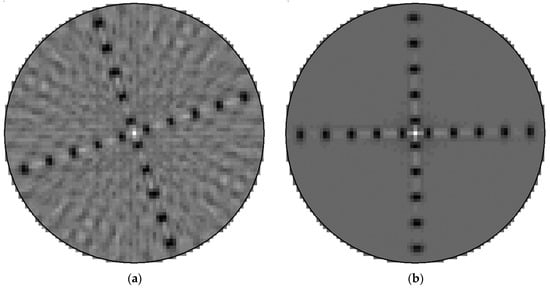
Figure 12.
Image reconstruction of 20 scatterers (Figure 7a) for the number of rotation angles (Doppler signal registration) (a) Nφ = 38 and (b) Nφ = 798.
7.2. Influence of the α Parameter in the Overlapping Algorithm
Once the optimal value for the number of Doppler signal registration angles had been determined with the aim of eliminating the error in reconstructing the coordinates of the inclusion image position, we proceeded to investigate the effect of the α parameter on the quality of DT imaging.
First, images were reconstructed for a large parameter value of α = 14.4°. Images of inclusions positioned at different distances from the center of rotation and at the same angles were reconstructed, as shown in Figure 7a, except that the inclusions were positioned every 5 mm from the center of rotation, the number of angles was increased (0°, 45°, 90°, 135°, 180°, 225°, 270°, 315°), and the number of inclusions was increased to 72. The previously determined optimal value of Nφ = 798 was used in the simulation. The results of this simulation are shown in Figure 13. To increase the dynamic range of imaging of the individual inclusions in relation to the surrounding background, the grey image background in Figure 13 was changed to white. It can clearly be seen that the shape images of the inclusions get longer as they move away from the center of rotation. This effect is undesirable as it falsifies the size and shape of the objects. It is, therefore, necessary to investigate whether it is possible to minimize these distortions by selecting a suitable, optimal value for the parameter α. It should also be noted that the greatest distortions occur for the inclusions furthest from the center of the imaging zone (center of rotation).
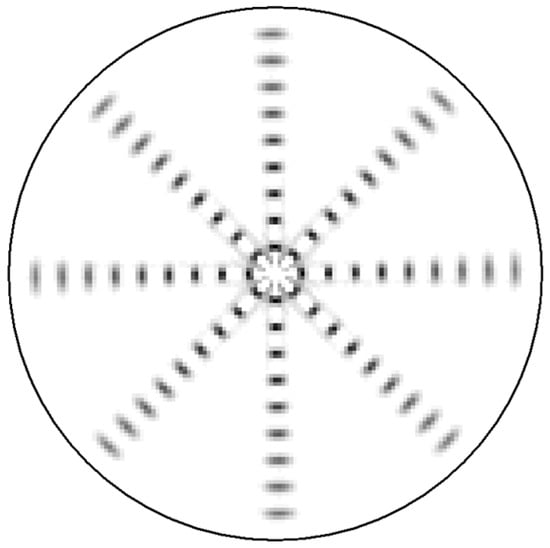
Figure 13.
Image reconstruction of 72 inclusions placed on a rotating platform every 5 mm from the center of rotation at angles of 0°, 45°, 90°, 135°, 180°, 225°, 270°, and 315°, respectively.
To find the optimal value of the parameter α for which the inclusion image would not be distorted, the inclusion image was reconstructed for different values of this parameter. As in previous studies, the experiments were divided into two parts. The first was for the 5 cm diameter imaging zone and the second for the 10 cm one. Since the greatest distortion (elongation) of the inclusion image occurs at the periphery of the imaging zones, images of scatterers located 2.5 cm and 5 cm from the center of rotation, respectively, and at an angle of 0° to the stationary ultrasound probe, were reconstructed in the 15 cm diameter imaging zone. The result of such a reconstruction of the inclusion placed at 2.5 cm for α = 5.4° is shown in Figure 14. To better observe the distortion, an ROI area of 3 cm × 3 cm was cropped from the whole image, which is also shown in Figure 14. In addition, the direction of the X and Y axes was determined in the ROI image, where the origin of the coordinate system coincides with the center of the inclusion image.
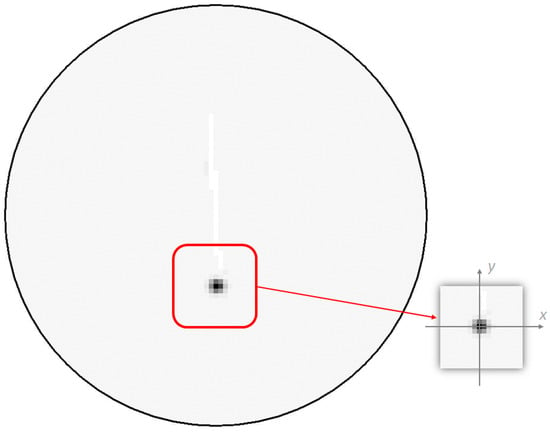
Figure 14.
Reconstruction of the image of an inclusion placed at a distance of 2.5 cm from the center of rotation, at an angle of 0° to the ultrasound probe, for a parameter α = 5.4°.
The image of the inclusion set 2.5 cm from the center of rotation was then reconstructed for an α parameter ranging from 0.9° to 18°. In Figure 15, ROIs (3 cm × 3 cm) for the reconstructed images are compared with each other.
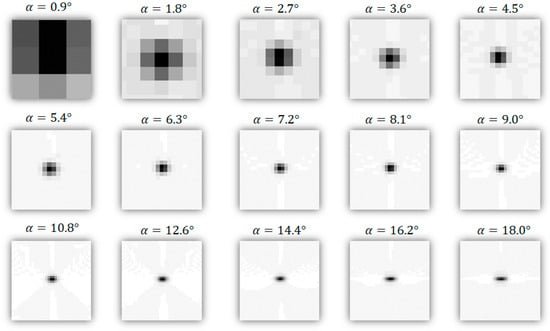
Figure 15.
Reconstructed images of an inclusion placed on a rotating platform at a distance of 2.5 cm from the centre of rotation, at an angle of 0° to the ultrasound probe, for parameter α = 0.9°, 1.8°, 2.7°, 3.6°, 4.5°, 5.4°, 6.3°, 7.2°, 8.1°, 9.0°, 10.8°, 12.6°, 14.4°, 16.2°, and 18.0°.
In Figure 15, it can be clearly seen that as the parameter α increases, the resolution of the DT image of the inclusion improves. The inclusion has a preset infinitesimally small diameter (point), so the smaller the diameter of the inclusion image, the better the representation and resolution of the DT image will be. However, once α = 10.8° is exceeded, a clearly visible elongation of the image appears in the X-axis direction.
To investigate the changes in the quality of the inclusion image, the resolution and blur of the point image were determined for each ROI case presented in Figure 15. These parameters were determined in two directions: along (X-axis) and across (Y-axis) the inclusion image. The resolution of the point (R [mm]) was determined by a 3 dB decrease in the amplitude of the pixel values relative to the maximum, which corresponds to a decrease of 70.7% on a linear scale. The point blur (B [mm]) was determined for 10% of the pixel amplitude value. This procedure is illustrated in Figure 16.
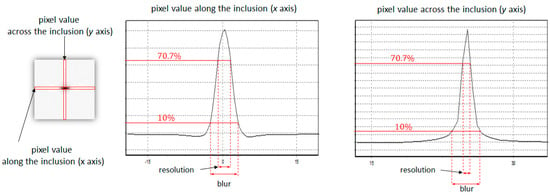
Figure 16.
Reconstruction of the inclusion image at a distance of 2.5 cm from the center of rotation for parameter α = 18.0°.
The results of the resolution and blurring of the inclusion image for the longitudinal (X-axis) and transverse (Y-axis) directions as a function of the α parameter are shown in Figure 17.
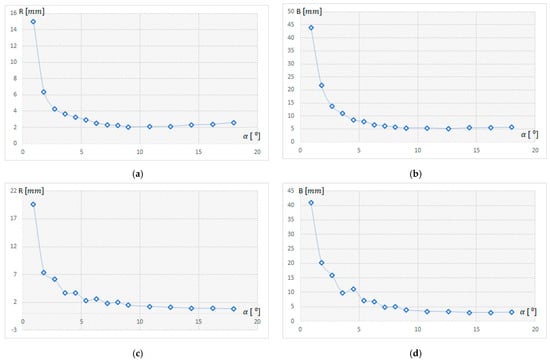
Figure 17.
Measurement results of the image quality parameters for an inclusion set 2.5 cm from the center of rotation for parameter α ranging from 0.9° to 18°: (a) resolution along (X-axis) the inclusion image; (b) blur along (X-axis) the inclusion image; (c) resolution across (Y-axis) the inclusion image; (d) blur across (Y-axis) the inclusion image.
As can be seen, in most cases, the resolution and blurring of the inclusion image improve exponentially as the parameter α increases. The exception is the resolution along the inclusion image shown in Figure 17a. There, a deterioration in resolution can be seen for values of α > 9°. This is confirmed by the earlier observations of the images in Figure 16. Therefore, it can be assumed that a value of α ≈ 9° is optimal for an imaging zone with a diameter of 5 cm. At this value of the α parameter, the resolution of the inclusion with a point diameter is 2.1 mm, while its blur is 5.4 mm.
Similar tests were carried out for the inclusion, which was placed at a distance of 5 cm from the center of the imaging zone (center of rotation). The results of the reconstructed images for the parameter α in the range of 0.9° to 18° are shown in Figure 18. The extension of the inclusion image for larger values of the parameter α is greater here than that of the image of the inclusion 5 cm away from the center of rotation (cf. Figure 18 of Figure 15).
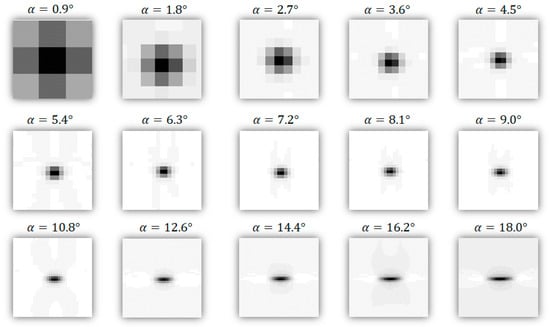
Figure 18.
Reconstructed images of an inclusion placed on a rotating platform at a distance of 5 cm from the center of rotation, at an angle of 0° to the ultrasound probe, for parameter α = 0.9°, 1.8°, 2.7°, 3.6°, 4.5°, 5.4°, 6.3°, 7.2°, 8.1°, 9.0°, 10.8°, 12.6°, 14.4°, 16.2°, and 18.0°.
As in the previous case, the resolution and blurring of the point-inclusion were again calculated for the longitudinal and transverse directions, for different values of the α parameter. The results of these calculations are shown in the graphs in Figure 19.
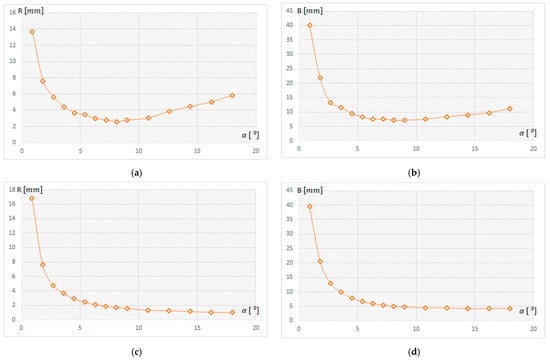
Figure 19.
Results of measurement of image quality parameters for an inclusion set 5 cm from the center of rotation for an α parameter ranging from 0.9° to 18°: (a) resolution along (X-axis) the inclusion image; (b) blur along (X-axis) the inclusion image; (c) resolution across (Y-axis) the inclusion image; (d) blur across (Y-axis) the inclusion image.
For the considered case of an inclusion placed at a distance of 5 cm from the center of rotation, the optimal resolution value is 2.2 mm, while the minimum blur is 5.9 mm. Based on Figure 19, it can be concluded that the optimal parameter α for an imaging zone with a diameter of 10 cm is 8.1°. This is smaller than that for an imaging zone with a diameter of 5 cm. Recall that the larger the parameter α, the smaller the dimensions of the inclusion image. Therefore, it can be concluded that as the diameter of the imaging zone increases, the imaging quality deteriorates. There is also a high correlation between the distance of the point from the center of rotation and the occurrence of unfavorable image blurring across the inclusion. The greater the blur in the distance, the greater the image for larger values of α. This can be observed in Figure 20, which shows the resolution and blurring across the image of inclusions placed at distances of 2.5 cm (imaging zone 5 cm) and 5 cm (imaging zone 10 cm) from the center of rotation.

Figure 20.
Measurement results of image quality parameters for the inclusion set 2.5 cm and 5 cm from the center of the imaging zone, for an α parameter ranging from 0.9° to 18°: (a) resolution along (X-axis) the inclusion image; (b) blur along (X-axis) the inclusion image.
From the point of view of the application of the overlapping algorithm, it is important to note that image blur appears for a similar value of the parameter α in both cases. Recall that for a point at a distance of 2.5 cm, while for a distance of 5 cm. The size of the time window of the Doppler signal depends on the value of the angle α and affects the resolution of the spectrum . The number of bands of the Doppler spectrum determines the number of tomographic measurement rays in each projection of the reconstruction sinogram, and this, in turn, determines the size and number of pixels of the imaging zone. Therefore, for a 5 cm diameter imaging zone (for α = 9.0°), the resolution of the entire image will be 49 × 49 pixels of 1 mm × 1 mm. For an imaging zone with a diameter of 10 cm (for α = 8.1°), the image deteriorates slightly to 89 × 89 pixels with dimensions of 1.1 mm × 1.1 mm. Given the size of the imaging zone, it is therefore important to determine the optimal value of the α parameter to achieve the best resolution and the minimum blurring of the image.
7.3. Influence of Rotation Frequency of the Probe (Or Test Object)
Another parameter that can potentially affect imaging quality is the rotation frequency of the ultrasound probe (or the object under examination) fturn. Thus, two cases of inclusions positioned at 2.5 cm and 5 cm from the center of rotation were examined for different values of the rotation speed. The images were reconstructed for the previously determined optimal values of the α parameters. The rotation rate fturn was varied from a value of 1 rps to 10 rps. The results of reconstructing images of inclusions set at 2.5 cm and 5 cm from the center of rotation are shown in Figure 21 and Figure 22, respectively.
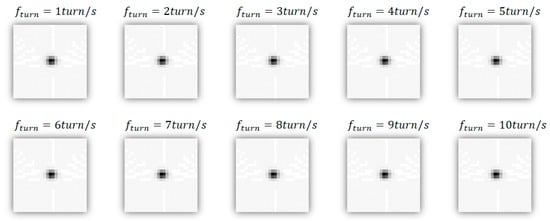
Figure 21.
Reconstruction of images of an inclusion placed on a rotating platform at a distance of 2.5 cm from the center of rotation, at an angle of 0° to the ultrasound probe, for rotation frequencies of 1 rps to 10 rps.
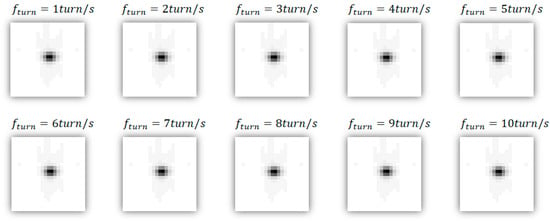
Figure 22.
Reconstruction of images of an inclusion placed on a rotating platform at a distance of 5 cm from the center of rotation, at an angle of 0° to the ultrasound probe, for rotation frequencies of 1 rps to 10 rps.
Note that for both inclusions, 2.5 cm and 5 cm away from the center of rotation, the image does not change as the rotation frequency increases. Neither the resolution nor the blurring of the inclusion image changes in either direction. The resolution of the whole image does not change when the rotation speed is changed, and it is 127 × 127 pixels for the 5 cm imaging zone and 115 × 115 pixels for the 10 cm imaging zone, respectively. Figure 23 compares the inclusion images for the two imaging zones studied, for a rotation frequency of . The difference in the dimensions of the reconstructed inclusion images is due to the use of two different α parameters (as analyzed earlier). The most important conclusion of the simulations performed here is that, for a given imaging zone diameter, the rotation frequency fturn does not affect the quality of the reconstructed image. This is particularly important because of the possibility of reducing the measurement data acquisition time in the DT method.
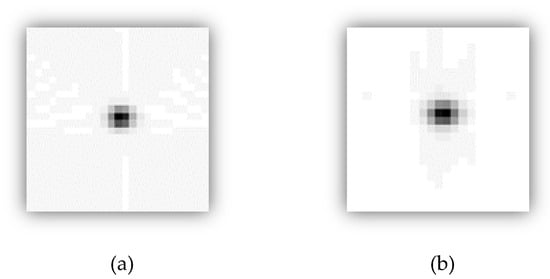
Figure 23.
Image reconstruction results of the inclusion for an ultrasound probe (or platform) rotating at 2 rps, for an inclusion distant from the center of rotation by (a) 2.5 cm and (b) 5 cm.
7.4. Influence of Water Temperature
In practical measurements, the Doppler ultrasound probe moving around the object under investigation should be acoustically coupled to the object so that the transmitted and received ultrasound wave is not significantly weakened by propagation to and from the object. The cheapest and best medium for this purpose is readily available water. Due to possible errors associated with the movement of water around the object caused by the rapid rotation of the transducer, the best solution would be to place the transducer in a sealed, thin-walled ring filled with a suitable fluid of low viscosity in which it could rotate. Acoustic coupling between the surface of the ring and the object under test can be provided by immersing the ring and the object in a tank of water (Figure 24).
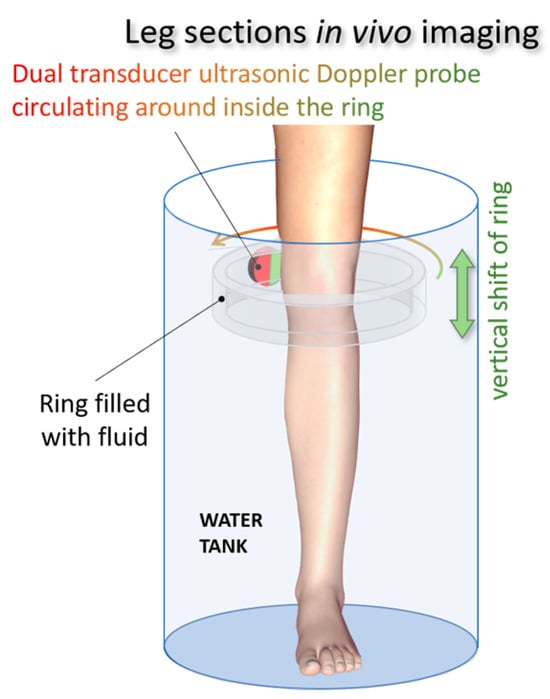
Figure 24.
Example of an in vivo examination of a human limb cross-section using the DT method with the ultrasound probe rotating inside a closed ring immersed together with the limb in a tank of water.
Due to the possibility of using water as an acoustic coupling in the DT method, this section investigates the effect of the temperature of the distilled water in which the test object is immersed on its imaging quality. In this simulation, the values of the previously optimized parameters were used, and the fturn frequency was set to 2 rps. Two inclusions were investigated, one 2.5 cm and the other 5 cm away from the center of rotation.
Temperature t affects the velocity of the ultrasonic wave cw, which appears in Formula (11) that defines the Doppler signal waveform from a rotating inclusion. It can also be seen that the Doppler frequency depends inversely on the value of the ultrasonic wave propagation velocity (Formula (7)). The influence of temperature on cw velocity was determined using the empirical Formula (13) and the coefficients defined for this formula in Table 1 [21]:
where t is the water temperature from 0 °C to 100 °C, and the coefficients ki are given in Table 1.

Table 1.
The ki coefficients for Equation (13) [20].
Using Formulas (11) and (13), it is possible to determine the Doppler signal for different temperature values and reconstruct the inclusion pattern from these. In the simulation, the water temperature range was changed from 18 °C to 40 °C, in 2 °C steps. The results are presented in Figure 25 and Figure 26.
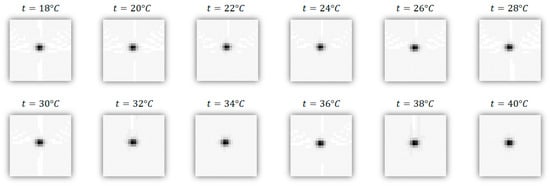
Figure 25.
Reconstruction of images of an inclusion placed on the rotating platform at a distance of 2.5 cm from the center of rotation, at an angle of 0° to the ultrasonic probe, for a water temperature t from 18 °C to 40 °C.
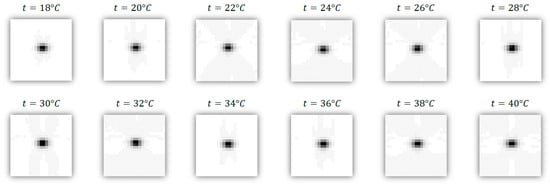
Figure 26.
Reconstruction of images of an inclusion placed on the rotating platform at a distance of 5 cm from the center of rotation at an angle of 0° to the ultrasonic probe, for a water temperature t from 18 °C to 40 °C.
Analyzing the images shown in Figure 25 and Figure 26, it can be seen that the resolution of the entire image deteriorates slightly with increasing temperature. In the case of Figure 25, for the temperature of the water surrounding the inclusion t = 18 °C, the resolution of the image is 127 × 127 pixels, while for t = 40 °C, it is equal to 125 × 125 pixels. It can therefore be assumed that the parameter t in the given range has very little effect on the image quality in the DT method; however, it should be noted that an increase in temperature causes a deterioration in image resolution.
8. Discussion
Doppler tomography uses a recorded continuous wave signal for image reconstruction, from which the Doppler frequency spectrum is determined after appropriate processing. Therefore, in this method, it is crucial to accurately determine the amplitudes of these frequencies. This, in turn, necessitates the best possible resolution of the Doppler signal spectrum. In this work, an overlapping algorithm was developed and investigated to improve this resolution. Its basic parameter is the angle α, which is responsible for the length (time window) of the Doppler signal for the rotation angles φ of the dual transducer ultrasonic Doppler probe rotated around the object cross-section under study. When the value of the parameter α is increased, the image of a single point inclusion decreases, while the resolution across the imaging zone improves significantly (Figure 15 and Figure 17, Figure 18 and Figure 19).
The investigations and analyses carried out in this work also showed that when the value of the parameter α is too high, the inclusion image is elongated in one direction. It was also observed that, for a given value of the parameter α, the distortion increases as the inclusion moves away from the center of rotation. It follows that the worst imaging conditions occur at the edge of the imaging zone. Therefore, it was investigated whether it is possible to improve the imaging quality of the inclusion when the imaging zone is reduced. To this end, reconstructed images of inclusions positioned at distances of 2.5 cm and 5 cm from the imaging center (axis of rotation), at the borders of two different imaging zones with diameters of 5 cm and 10 cm, were analyzed. In both cases, the images of these inclusions were reconstructed for different values of the parameter α. The plotted characteristics of the change in resolution and blurring of the images along and across the image of the point showed that the optimal values of α could be selected due to the best resolution and least blurring of the inclusion image (Figure 20). For an imaging zone with a diameter of 10 cm, this is α = 8.1°, while for an imaging zone with a diameter of 5 cm, it is α = 9.0°. The optimal resolution and point blur for these two imaging zones and the optimal values of the α parameter are R ≈ 2.2 mm, B ≈ 5.9 mm and R ≈ 2.1 mm, B ≈ 5.4 mm, respectively. Therefore, it was determined that DT image quality could be improved by reducing the imaging zone.
An equally important parameter in DT imaging is the number of rotation angles φ. Here, however, the nature of the error introduced when the number of angles Nφ is too small is quite different, involving a change in the reconstruction coordinates of the inclusion in the imaging zone (Figure 9, Figure 10 and Figure 11). For small values of Nφ, the inclusion image is reconstructed with a significant angular shift with respect to the given coordinates of inclusion in the imaging zone. It was found that this error becomes imperceptible for Nφ > 798.
The study also showed that the speed of rotation of the Doppler measurement probe around the object has no effect on the reconstructed image of the inclusion (Figure 21 and Figure 22). This means that it is possible to use fairly fast probe rotations of a few turns per second without any deterioration in image quality.
In the present study, the influence of the temperature of the water in which the test object is immersed on the DT imaging quality was also investigated for a wide temperature range from 18 °C to 40 °C. It was found that increasing the water temperature results in a slight deterioration of the resolution of the inclusion image (Figure 25 and Figure 26); however, this effect is small, and the quality of the inclusion image is not significantly affected.
9. Conclusions
The research carried out in this study into the method and parameters of acquisition, processing, and reconstruction of measurement data allows for optimization of these procedures and algorithms in the context of obtaining the best possible DT image quality characterized by the highest possible resolution and the lowest possible blurring of visualized structures that scatter the ultrasonic wave in the examined object cross-section. As it turns out, in the DT method, the image quality deteriorates, regardless of the measurement accuracy, the value of the amplitude and frequency of the receiving signal, and the amount of noise and interference of the receiving signal (both on the acoustic and electrical side) recorded with the receiving transducer of the ultrasonic Doppler probe. It would be expected that for the simulation of an ideal Doppler signal obtained by rotating pins with a point diameter perfectly scattering ultrasound, very good imaging resolution, in the order of micrometers, could be obtained. However, studies have shown that for optimally chosen parameter values, point-diameter scatterers are visualized with a resolution of no better than about 2 mm and a blur of no less than about 5 mm.
The main reason for these limitations in the DT method is the need to determine the Doppler frequencies contained in the time-varying continuous signal (recorded during one rotation) and the associated problem of windowing the Doppler signal for the STFT transform. The cause of the significant angular shifts of the inclusion image in the imaging zone is an angular window that is too large (a small number of angles Nφ). In turn, a large window increases the resolution of the Doppler spectrum and thus increases the number of image pixels, thereby reducing their size. It is possible to maintain large windows and a large number of rotation angles using larger values of the “dilation angle” α of Doppler signal acquisition with the use of time window overlapping. However, it appears that there is a certain optimal value for this parameter, depending on the diameter of the imaging zone.
A very important conclusion of the study is the independence of the quality of the reconstructed DT image from the speed of rotation of the ultrasound probe around the object. If we consider the possibility of using this method in medical diagnostics for in vivo tissue section imaging (Figure 24), it is possible to significantly reduce the examination time by using a higher rotation speed of the probe around the examined object (e.g., limb, breast). As a result, it is not necessary to keep the patient’s body part under examination motionless for long periods of time. In addition, when the probe rotates at a speed of, e.g., 10 rps, it is possible to record data for the reconstruction of 10 different sections of the examined object using the shift of the rotating probe. This means that in a time period of, e.g., 20 s, it is possible to record signals for the reconstruction of 200 different cross-sections. The FBP transform image reconstruction algorithm used here makes it possible to reconstruct a DT image of a single cross-section in the order of a few milliseconds, which makes it possible to achieve temporal resolution of imaging in the order of a few to about 10 fps (image frames per second) and enables real-time imaging of object cross-sections. Of course, the construction limitations associated with such rapid probe rotation and the ability to realize uninterrupted measurements still need to be taken into account, so it seems that the limit would be a rotation speed inside the ring of about 10 rps.
The slight deterioration of the resolution of the DT image with increasing water temperature is also related to the windowing of the Doppler signal, because in the range up to 40 °C, the ultrasound propagation velocity in the water increases with temperature [21], and thus the maximum Doppler frequency also increases slightly (see Formulas (7) and (11)), which, for a given STFT time window length, reduces the resolution of the Doppler spectrum and thus reduces the number of image pixels in the imaging zone.
10. Summary
The disadvantage of the DT method is the need to use highly sensitive measurement techniques due to the very narrow range of recorded frequency variations of ultrasound and electrical signals, which necessitates the construction of low-noise ultrasound transducers and electronic systems. However, the effective range of tissue examination is greater than in conventional ultrasound imaging (due to the use of continuous wave), provided that DT imaging is achieved in a similar or better spatial resolution. A potential application is imaging of well-reflecting bone structures with ultrasound waves. Such studies could be performed to monitor fracture adhesions and traumatic bone injuries in the extremities (Figure 24). The Doppler tomography scanner could consist of a circular ring in which an ultrasound probe would move, connected to a transmitting and receiving system via electrical rotating sliding connectors. The ring would be placed in a tank of distilled water into which the patient inserts the limb. During the test, the ring moves along the leg or arm, reconstructing images in 2D cross-sections. In the DT method, it is possible to use the 3D acquisition and reconstruction of the measurement data by simultaneously applying circular geometry in the horizontal plane and linear geometry along the height of the object (Figure 24). Similarly, it would be possible to image the 3D structure of the breast to detect cancerous lesions or visualize the subcutaneous blood vessels of the neck (e.g., the common carotid artery), with the possibility of an additional blood flow study if the ultrasound probe is stationary.
The main advantage of Doppler tomography is the potential for constructing a low-cost device for reconstructing tissue cross-sectional images. The device is based on a two-transducer ultrasonic probe with an uncomplicated design, which significantly reduces production costs. Additionally, the circuitry necessary to process the recorded Doppler signal is known and is currently used in Doppler flowmeters to measure blood flow velocity.
The resolution of the DT method can be further improved by adding samples with zero values at the edges of the overlapping time windows of the Doppler signal (zero-padding technique) to increase both temporal and frequency resolution [22]. Another way to improve image quality is through appropriate filter selection in the FBP algorithm used [4,23]. In the image reconstruction process, all projections are filtered in the frequency domain and multiplied by a window function (e.g., Hamming window). Formally, this is the corresponding filter function to eliminate noise in the reconstructed image [2,4]. It is still possible to apply a more computationally demanding algorithm to the reconstruction of DT images, which can allow higher spatial resolution imaging by operating directly on I/Q sampling data and using so-called coherent processing [11].
Author Contributions
Conceptualization, T.Ś. and K.J.O.; methodology, T.Ś.; validation, T.Ś. and K.J.O.; formal analysis, T.Ś. and K.J.O.; investigation, T.Ś. and K.J.O.; data curation, T.Ś. and K.J.O.; writing—original draft preparation, T.Ś.; writing—review and editing, T.Ś. and K.J.O.; visualization, T.Ś.; supervision, K.J.O. All authors have read and agreed to the published version of the manuscript.
Funding
This research received no external funding.
Data Availability Statement
Data are contained within the article.
Conflicts of Interest
The authors declare no conflicts of interest.
References
- Liang, H.D.; Halliwell, M.; Johnson, S.; Wells, P.N.T. Incoherent imaging using continuous wave ultrasound. A preliminary study using bovine intervertebral disc. Eur. J. Ultrasound 2003, 16, 253–260. [Google Scholar] [CrossRef] [PubMed]
- Świetlik, T.; Opieliński, K.J. Analysis for improvement of doppler tomography imaging of objects scattering continuous ultrasonic waves. Arch. Acoust. 2020, 45, 329–339. [Google Scholar] [CrossRef]
- Tsui, C.S.L.; Liang, H.-D.; Halliwell, M.; Shere, M.; Braybrooke, J.P.; Whipp, E.; Wells, P.N.T. Coherent Ultrasonic Doppler Tomography. Ultrasound Med. Biol. 2011, 37, 642–650. [Google Scholar] [CrossRef] [PubMed]
- Kak, A.C.; Slaney, M. Principles of Computerized Tomographic Imaging; Society for Industrial and Applied Mathematics: Philadelphia, PA, USA, 2001; p. 327. [Google Scholar]
- Nagai, K.; Greenleaf, J.F. Ultrasonic imaging using the Doppler effect caused by a moving transducer. Opti. Eng. 1990, 29, 1249–1254. [Google Scholar] [CrossRef]
- Liang, H.D.; Halliwell, M.; Wells, P.N.T. Continuous wave ultrasonic tomography. IEEE Trans. Ultrason. Ferroelectr. Freq. Control 2001, 48, 285–292. [Google Scholar] [CrossRef] [PubMed]
- Kirkhorn, J. Introduction to IQ-demodulation of RF-data. IFBT NTNU 1999, 15, 13. [Google Scholar]
- Tatsuro, B. Complex Digital Filter Designs for Audio Processing in Doppler Ultrasound System. In Applications of Digital Signal Processing; Cuadrado-Laborde, C., Ed.; InTech: Rijeka, Croatia, 2011; pp. 211–236. [Google Scholar]
- Zhang, Y.; Li, S.; Wang, Y.; Sun, Y.; Huang, T.; Xiang, W.; Li, C. Iterative optimization algorithm with structural prior for artifacts removal of photoacoustic imaging. Photoacoustics 2025, 44, 100742. [Google Scholar] [CrossRef] [PubMed]
- Peng, X.; Xu, Z.; Dentinger, A.; Kewalramani, S.; Jo, J.; Xu, G.; Chamberland, D.; Abdulaziz, N.; Gandikota, G.; Mills, D.; et al. Longitudinal volumetric assessment of inflammatory arthritis via photoacoustic imaging and Doppler ultrasound imaging. Photoacoustics 2023, 31, 100514. [Google Scholar] [CrossRef] [PubMed]
- Liang, H.D.; Tsui, C.S.L.; Halliwell, M.; Wells, P.N.T. Continuous wave ultrasonic Doppler tomography. Interface Focus 2011, 1, 665–672. [Google Scholar] [CrossRef] [PubMed]
- Opieliński, K.J.; Gudra, T. Ultrasonic Transmission Tomography. In Industrial and Biological Tomography—Theoretical Basis and Applications; Sikora, J., Wójtowicz, S., Eds.; Electrotechnical Institute: Warsaw, Poland, 2010. [Google Scholar]
- Lewitt, R.M. Reconstruction algorithms: Transform methods. Proc. IEEE 1983, 71, 390–408. [Google Scholar] [CrossRef]
- Dobrucki, A.B.; Opieliński, K.J. Adaptation of image reconstruction algorithm for purposes of ultrasound transmission tomography (UTT). Arch. Acoust. 2000, 25, 395–422. [Google Scholar]
- Świetlik, T.; Opieliński, K.J. Analysis of the possibility of Doppler tomography imaging in circular geometry. In Information Technologies in Medicine, Advances in Intelligent Systems and Computing; Piętka, E.A., Ed.; Springer International Publishing: Cham, Switzerland, 2019; Volume 762, pp. 52–63. [Google Scholar]
- Censor, Y. Finite series-expansion reconstruction methods. Proc. IEEE 1983, 71, 409–419. [Google Scholar] [CrossRef]
- Fiori, G.; Fuiano, F.; Scorza, A.; Schmid, M.; Galo, J.; Conforto, S.; Sciuto, S.A. Doppler Flow Phantom Stability Assessment through STFT Technique in Medical PW Doppler: A preliminary study. In Proceedings of the 2021 IEEE International Workshop on Metrology for Industry 4.0 & IoT Conference, Rome, Italy, 7–9 June 2021. [Google Scholar]
- Gonçalves, I.B.; Leiria, A.; Moura, M.M.M. STFT or CWT for the detection of Doppler ultrasound embolic signals. Int. J. Numer. Methods Biomed. Eng. 2013, 29, 964–976. [Google Scholar] [CrossRef] [PubMed]
- Rabiner, L.R.; Schafer, R.W. Digital Processing of Speech Signals; Prentice Hall: Englewood Cliffs, NJ, USA, 1978. [Google Scholar]
- Rabiner, L.R.; Schafer, R.W. Introduction to Digital Speech Processing; Now Publishers Inc.: Boston, MA, USA; Delft, The Netherlands, 2007. [Google Scholar]
- Marczak, W. Woda jako wzorzec w pomiarach prędkości propagacji ultradźwięków w cieczach. In Akustyka Molekularna i Kwantowa 17; Oddział Górnośląski PTA: Kraków, Poland, 1996. (In Polish) [Google Scholar]
- Świetlik, T. Reconstruction of the image of structure well reflecting the ultrasound wave by using Doppler tomography method. In Acoustics, Acoustoelectronics and Electrical Engineering; Witos, F., Ed.; Wydawnictwo Politechniki Śląskiej: Gliwice, Poland, 2021; pp. 345–364. [Google Scholar]
- Opielinski, K.J.; Gudra, T. Multi-parameter ultrasound transmission tomography of biological media. Ultrasonics 2006, 44, e295–e302. [Google Scholar] [CrossRef] [PubMed]
Disclaimer/Publisher’s Note: The statements, opinions and data contained in all publications are solely those of the individual author(s) and contributor(s) and not of MDPI and/or the editor(s). MDPI and/or the editor(s) disclaim responsibility for any injury to people or property resulting from any ideas, methods, instructions or products referred to in the content. |
© 2025 by the authors. Licensee MDPI, Basel, Switzerland. This article is an open access article distributed under the terms and conditions of the Creative Commons Attribution (CC BY) license (https://creativecommons.org/licenses/by/4.0/).